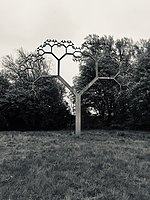
Magdalen College, Oxford
Magdalen College (/ˈmɔːdlɪn/ MAWD-lin)[4] is a constituent college of the University of Oxford.[5] It was founded in 1458 by Bishop of Winchester William of Waynflete.[6] It is one of the wealthiest Oxford colleges, as of 2022,[3] and one of the strongest academically, setting the record for the highest Norrington Score in 2010 and topping the table twice since then.[7] It is home to several of the university's distinguished chairs, including the Agnelli-Serena Professorship, the Sherardian Professorship, and the four Waynflete Professorships.
"Magdalen College" redirects here. For other uses, see Magdalen College (disambiguation).The large, square Magdalen Tower is an Oxford landmark, and it is a tradition, dating to the days of Henry VII, that the college choir sings from the top of it at 6 a.m. on May Morning.[8] The college stands next to the River Cherwell and the University of Oxford Botanic Garden. Within its grounds are a deer park and Addison's Walk.
History[edit]
Foundation[edit]
Magdalen College was founded in 1458 by William of Waynflete, Bishop of Winchester and Lord Chancellor of England[6] and named after St Mary Magdalene. The college succeeded a university hall called Magdalen Hall, founded by Waynflete in 1448, and from which the college drew most of its earliest scholars.[9] Magdalen Hall was suppressed when the college was founded. The name was revived for a second Magdalen Hall, established in the college's grounds around 1490, which in the 19th century was moved to Catte Street and became Hertford College.[10][11]
Waynflete also established a school, now Magdalen College School, a private school located nearby on the other side of the Cherwell. Waynflete was assisted by a large bequest from Sir John Fastolf, who wished to fund a religious college.[12]
Magdalen College took over the site of St John the Baptist Hospital, alongside the Cherwell, initially using the hospital's buildings until new construction was completed between 1470 and 1480.[13] At incorporation in 1458, the college consisted of a president and six scholars. In 1487 when the Founder's Statutes were written, the foundation consisted of a President, 40 fellows, 30 demies, four chaplain priests, eight clerks, 16 choristers, and appointed to the Grammar School, a Master and an usher.[9]
The founder's statutes included provision for a choral foundation of men and boys (a tradition that has continued to the present day) and made reference to the pronunciation of the name of the college in English. The college's name is pronounced like the adjective maudlin because the late medieval English name of Mary Magdalene was Maudelen, derived from the Old French Madelaine.[14]























